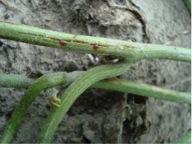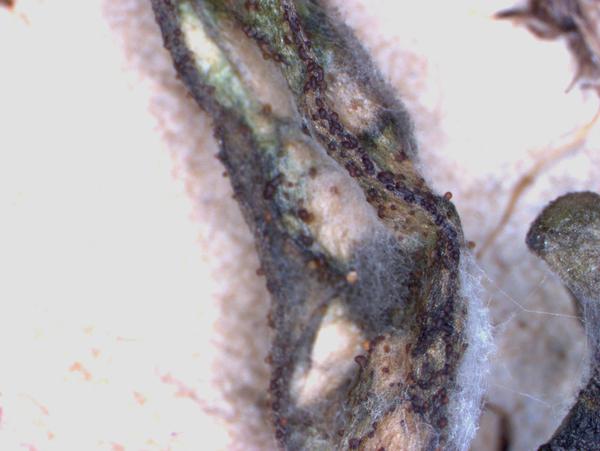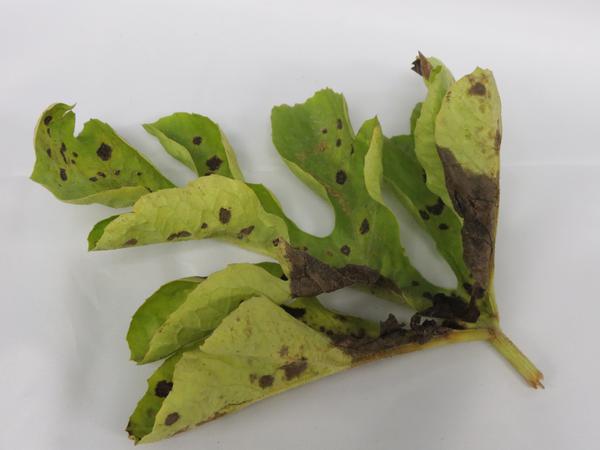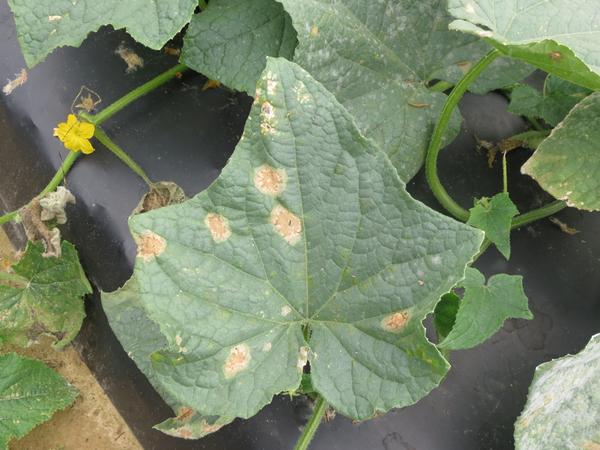Pathogen
Gummy stem blight, also known as black rot when affecting fruits, is caused by the fungal pathogen Didymella bryoniae (anamorph = Phoma cucurbitacearum).
Host Crops and Plants
Gummy stem blight affects all cucurbit crops such as cucumber, watermelon, melon, cantaloupe, squash, and pumpkin.
Host Parts Affected
Stems, vines, leaves, and fruits are affected by gummy stem blight, which can result in yield reduction, damaged fruit (black rot), and plant death.
Identification
Gummy stem blight causes ovate stem and vine cankers, usually starting near the nodes, with a characteristic brown gummy exudate (Figure 1). Within advanced lesions on dead tissue, small black fungal fruiting bodies, known as pycnidia, can be seen with a 10x hand lens (Figure 2). Pycnidia contain pathogen conidia (Figure 3). Leaves can exhibit dark brown circular spots starting at margins and rapidly spreading to entire leaf. These foliar lesions can vary in color from light brown to nearly black (Figure 4). Black rot infected fruits show small water-soaked spots that advance into large brown spots, sometimes also exhibiting the brown gummy secretion as found in stems (Figure 5).
Similar Diseases
Gummy stem blight and black rot can look like other plant diseases that affect cucurbits; however, this pathogen can be distinguished by stem and vine lesions near nodes, black fruiting bodies on dead tissue along with the characteristic brown gummy exudate from wounds near lesions. The following are images to help distinguish gummy stem blight from those diseases that can have similar symptoms during some life stages:
Favorable Environmental Conditions for the Disease
- High humidity and moisture (4–10 hours of persistent moisture) with frequent rains, overhead irrigation, and/or poor drainage
- Warm temperatures between 61 and 75°F
- This disease can occur early in seedlings and greenhouse transplants, as well as anytime throughout the season. Maximum damage in North Carolina is usually seen in late June and July.
Disease Transmission
Gummy stem blight can live on seeds transported from state to state. The spores can also be spread state to state by wind. Locally, gummy stem blight can be spread by asexual reproductive structures, conidia, in the gum during rains or watering. This pathogen can also survive for several years on un-decomposed cucurbit plant material and on volunteers of related species. It may also attack other host plants such as green beans, okra, tomato, and tobacco, and may overwinter on the refuse from these crops. The spores of the fungi germinate and infect young seedlings through the hypocotyl or stem. Cotyledons and young leaves of cantaloupe and watermelon are more susceptible than those of cucumber and pumpkin.
General Disease Management
- Purchase seeds or seedlings free of pathogens from a reputable company, no resistant cucurbit varieties exist. Consider seed treatments.
- Inspect seedlings regularly for symptoms and dispose of all seedlings near infected plants.
- Deep plow infected areas post-harvest to ensure complete decomposition of all plant material.
- Rotate crops, carefully removing all volunteers of relates species. Since this disease can survive in soil and on un-decomposed plant material for 2-4 years, rotate all cucurbits out of infected areas for at least that long. Crop rotations with non-host plants such as small grain, corn, of two or more years are effective in reducing the incidence of these diseases, if disease-free seed are used.
Disease Control for Conventional Growers
Fungicides may be required to control gummy stem blight, especially if environmental conditions are favorable for disease. When applying fungicides, always remember to alternate products to avoid generating fungicide-resistant strains. For the latest fungicide recommendations for gummy stem blight see the Southeastern US Vegetable Crop Handbook. Fungicide labels are legal documents, always read and follow fungicide labels.
Example products for gummy stem blight control:
| Active ingredient | Example product | Pre-harvest Interval (day) | Fungicide group |
|---|---|---|---|
| Potassium phosphite + TebuconazoleG | Viathon 5.1SC | 7 | 3 |
| Difenoconazole + CyprodinilG | Inspire Super 2.09SC | 7 | 3 + 9 |
| Fluopyram + TebuconazoleG | Luna Experience 400SC | 7 | 7 + 3 |
| Fluopyram + TrifloxystrobinG | Luna Sensation 500SC | 0 | 7 + 11 |
| PenthiopyradG | Fontelis 1.67SC 16 fl oz | 1 | 7 |
| Cyprodinil + FludioxonilG | Switch 62.5WG | 1 | 9 + 12 |
| Potassium phosphite + ChlorothalonilG | Catamaran 5.3SC | 1 | M |
| Fluxapyroxad + Pyraclostrobin | Merivon | 0 | 7 + 11 |
| Pyraclostrobin + Boscalid | Pristine | 0 | 7 + 11 |
| Chlorothalonil | Bravo Weather Stick 6SC | 0 | M |
| G Can be used in greenhouses, see label for restrictions R Fungicide resistance reported B Use only before disease |
|||
For example, in watermelon you can use: Bravo alternated with Viathon, alternated with Luna Sensation, alternated with Switch every 7 days.
Useful Resources
- The NC State University Plant Disease and Insect Clinic provides diagnostics and control recommendations
- The NC State Extension Plant Pathology Portal provides information on crop disease management
- The Southeastern US Vegetable Crop Handbook provides information on vegetable disease management
- The USDA Fungus-Host Distributions Database provides information about reported hosts for fungal and oomycete pathogens
Acknowledgements
This factsheet was prepared by the NC State University Vegetable Pathology Lab in 2013.
Publication date: Dec. 16, 2018
Reviewed/Revised: Jan. 9, 2023
There is an alternate Spanish language version of this document here: Pudrición gomosa del tallo en cucurbitáceas
Recommendations for the use of agricultural chemicals are included in this publication as a convenience to the reader. The use of brand names and any mention or listing of commercial products or services in this publication does not imply endorsement by NC State University or N.C. A&T State University nor discrimination against similar products or services not mentioned. Individuals who use agricultural chemicals are responsible for ensuring that the intended use complies with current regulations and conforms to the product label. Be sure to obtain current information about usage regulations and examine a current product label before applying any chemical. For assistance, contact your local N.C. Cooperative Extension county center.
N.C. Cooperative Extension prohibits discrimination and harassment regardless of age, color, disability, family and marital status, gender identity, national origin, political beliefs, race, religion, sex (including pregnancy), sexual orientation and veteran status.







